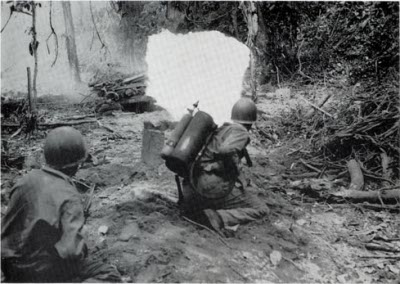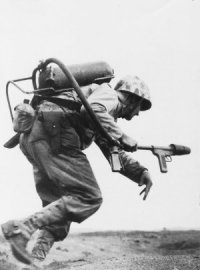![]() The Pacific War Online Encyclopedia
The Pacific War Online Encyclopedia
|
| Previous: FK-51, Dutch Trainer Aircraft | Table of Contents | Next: Fleet Carriers (CV) |

U.S. Army. Via militaryphotos.net
Flamethrowers are weapons that shoot flaming
liquid at enemy positions. They are typically short in range, rapidly
exhaust their fuel, and are hazardous to employ; but they proved very
effective at reducing fortifications.
They were little used by the Japanese,
who rarely found themselves in a tactical situation requiring the
reduction of Allied
fortifications, but they found extensive use in the hands of Allied
forces in the Pacific theater, beginning particularly with the New Georgia campaign.

U.S. Marine Corps. Via ibiblio.org
Flamethrowers originally took the form of a
man-portable weapon. The operator carried two or three cylinders on his
back. One contained an inert propellant gas such as nitrogen and the
other one or two cylinders contained the incendiary mixture. The
propellant gas forced the incendiary through a hose and nozzle held by
the operator. Some arrangement was made for igniting the fuel as it
left the nozzle, such as an electrical ignitor or a pilot flame.
The principal Japanese flamethrower of the war was the Type
93, which consisted of two fuel tanks and a nitrogen pressure cylinder.
Ignition was achieved using a blank cartridge, ten of which were placed
in a revolving cylinder at the nozzle end of the flamethrower. Range was
25 to 30 yards (23 to 27 m) and the 3.25 gallons of fuel could be
exhausted in 10 to 12 seconds of continuous fire. The flamethrower
weighed about 55 lbs (89 kg).
Later
in the war, flamethrowers were mounted on armored vehicles that
protected the operator and made it safer to approach within range of
the target. Flamethrower tanks were
extensively, and effectively, used at Okinawa.
When even tanks proved vulnerable to antitank fire, U.S. Army troops
began connecting long fire hoses to the incendiary containers in their
flamethrower tanks and creeping close to the objective to douse it in
fuel. The soldiers did not have to carry clumsy and vulnerable fuel
cylinders and the tanks did not have to expose themselves to enemy fire.
Curiously, there were reports that the Russians used flamethrower tanks as early as the battle of Nomonhan in the summer of 1939 (Goldman 2012).
It is unclear whether the Russian practice influenced American armored
tacticians or the western Allies developed their flamethrower tanks
independently.
The incendiary mixture was originally gasoline,
kerosene, or some other flammable hydrocarbon. The Americans replaced this with
napalm, a thick mixture of gasoline
and fatty acids similar to those in
soap. The thicker mixture could be shot to a longer distance and burned
more effectively.
Flamethrowers were effective against bunkers
because they did not need to actually hit the soldiers inside. The burning fuel could be splashed against walls or ceiling
to spread flames throughout the bunker, and the burning fuel rapidly
consumed the oxygen within the confined space. A person hit directly by
the fuel suffered a cruel if swift death, but those not hit were still
forced to either evacuate the bunker or suffocate.
References
The Pacific War Online Encyclopedia © 2008, 2010, 2013 by Kent G. Budge. Index